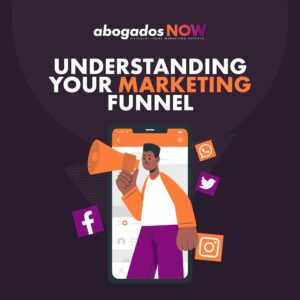Marketing is one of the most important investments your law firm can make. It is how you establish respect and authority in your industry, how you attract new clients, and how you establish recognizability. To engage in meaningful marketing, it is important to understand your marketing funnel.
The first thing to understand is that the “marketing funnel” has a lot of different names. Some call it the sales funnel, others call it the customer journey…but despite the various terms in use, the core concept is always the same. The marketing funnel describes the process of drawing people into your brand and converting them into clients. It is described as a funnel because it helps to filter a wide audience into an actionable list of prospects. Let’s illustrate what we mean:
Stage 1: Strangers.
This is the first stage in the marketing funnel, and it is the biggest/widest. This stage can include absolutely anyone and everyone. It includes the individuals who have not yet worked with your firm. You do not know these people and they do not know you…yet. This stage has the most potential, but at the same time, it can be almost too large. It technically includes everyone in the globe, but if you are only looking to service clients in your local area, you can engage in marketing efforts that shrink your pool of strangers by doing things like running local ads or putting up local billboards.
Stage 2: Visitors.
This stage is slightly smaller (a pattern you will see continued as we move down the funnel). Strangers convert to visitors when they become aware of your brand. Maybe someone did a google search for legal services and clicked on your ad. Maybe someone saw a billboard and decided to look you up. Maybe someone was reading an article about local law and found a link back to your site…now they are visiting you. They know who you are, but it isn’t yet clear if an attorney/client relationship will be beneficial to either one of you. Not every stranger will become a visitor- there will be some attrition along the way, and the same is true of every stage in the funnel.
Stage 3: Prospect.
A visitor becomes a prospect when they consider working with you. Most firms choose to define this stage by contact. If a visitor on your site chooses to fill out a form, call you, or email you, they have initiated contact and they are now a prospect, which means they are more likely to actually engage in business with you than a visitor is. Once again, not all visitors will become prospects, and so this stage is smaller than the two above it (are you picturing a funnel yet?).
Stage 4: Opportunity
Once you begin a dialog with a prospect, they can become an opportunity. You see, just because someone reaches out to your firm does not mean that they are a good fit for your services. A lot of website form-fills actually come from vendors looking to sell you something. Those people will not progress beyond the prospect stage, since they do not represent a potential client. If, however, you speak to a prospect and it sounds like you can help them with their legal issues, they become an opportunity for your firm.
Stage 5: Client
An opportunity becomes a client when a contract is signed and the work on their case begins. The beauty of digital marketing is that no one can make it to the client stage without hitting every other stage that precedes it. In order for someone to become a client, they have to progress all the way from stranger, to visitor, to prospect, and to opportunity. It isn’t possible to jump stages. Once you understand what those stages are and their characteristics, it becomes much easier to predict the flow of your incoming business, and to make changes to your marketing efforts that maximize your marketing funnel conversion rates.
Understanding the marketing funnel is the first step in designing a strong marketing strategy. The next step is setting marketing goals, followed by brainstorming, testing, evaluating, and adjusting. Brainstorming is often the hardest part for people. If you are struggling there, check out our 4 ideas for boosting your law firm’s marketing strategy in 2021.
Remember that the marketing experts at Abogados NOW are always here to help. We can help define and build the funnel within your organization, come up with actionable marketing goals, and create a plan that will help you to achieve those goals. You do not have to face the daunting task of managing your marketing funnel alone. Instead, call us!





